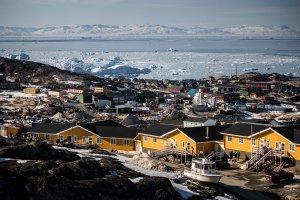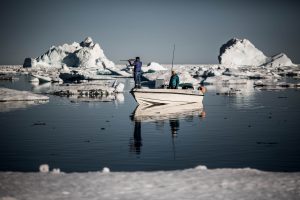When Borgen goes to Greenland

Borgen: Power and Glory

The Bowhead Whale can boast not only of its appearance in Season 4 of Borgen, but also of its status as the world’s most padded baleen whale, and its history of coming close to extinction. Due to the absence of commercial whaling and the favourable Greenlandic living conditions, the Bowhead Whale has now fought itself back to a viable population. In many ways a true whale-fighter.

Borgen: Power and Glory

If you have seen the opening scene in Borgen: Power and Glory, then you definitely noticed the whale: a Bowhead Whale, the dissection of which begins in this scene. Whale hunting is an ancient tradition in Greenland, a deeply rooted part of the local hunting culture. When a whale is caught, the community gathers; this is a meeting point for hunters and residents in the settlements – this is also shown in the scene in Borgen. Whale meat has always been a central food source for Inuit in Greenland, and it has never been the local hunt that has threatened populations. In Greenland since 2008, local hunters have been allowed to hunt two individual Bowhead Whales per year, although it has not actually been an important tradition to eat Bowhead Whale. For this reason, the annual quota is often rolled over to the following year. Bowhead Whale does not taste quite as good as other whales, such as Minke Whale, Fin Whale or Humpback Whale, which are the whales that are more often seen in the local food culture. However, Bowhead Whale is often used as food for sled dogs.
Why are whales hunted in Greenland - can they be eaten?
The Inuit cultures in Greenland have been dependent on natural resources (such as fish, birds, and land and sea mammals) since they first migrated to Greenland between 4 and 5,000 years ago. Historically, sea mammals have played a central nutritional role for a population in a country with very limited possibilities for agriculture.
Are whale products used today?
The amount of agricultural land in Greenland has not increased, and most food products are still imported by ship. As a result, local sources of food, such as whale meat, are still an important and much-loved part of the food culture in Greenland.
Products made of whale?
Inuit cultures have managed, throughout generations, to create and perfect unique products out of materials from the animals they hunt, such as kayaks, ulo (the women’s knife), umiaq (the women’s boat), soapstone lamps, harpoons and bird spears, as well as skin clothes of very high quality. Products from whales were used in these, such as their strong bones and their long jawbones. Their baleen and blubber were burned in soapstone lamps to create light and a source of warmth in tents or in turf huts.
Do people still hunt in Greenland?
Today, many children still catch their first grouse or seal when they are still in their first years of school. The first catch is a huge event, which is celebrated to the same extent as birthdays. Neighbours and family members are invited to a kaffemik (a traditional gathering in a Greenlandic home). The hunt for the bigger whales, such as Humpback Whales, Minke Whales and Fin Whales, is for commercial hunters who have a licence and can sell the meat afterwards. All three whales are still a beloved delicacy in Greenland.
Is whale hunting affected by climate changes?
Ice fishing in Northern Greenland is affected by climate changes, which have already led to shorter periods with ice, much thinner ice or even no ice at all in the winter, and more unstable weather. This challenges hunters’ movement on the ice, ice fishing, seal hunting and hunting of the big whales.

The Bowhead Whale is the only baleen whale that spends its winters in Greenland, and this is a serious undertaking. The Bowhead Whale is not very long, but it is padded – it actually has the world’s thickest layer of fat, at up to 50-60 cm thick. Indeed, a lot of crustaceans have to come through this baleen whale’s filter-feeding system in order to form such a thick layer of blubber – about 3-4 tonnes of crustaceans a day in actual fact. And this thick layer of fat is indispensable, as it ensures that the whale can stay warm all year round in the ice-cold Greenlandic sea.
The Bowhead Whale’s particularly dense structure, with its incredibly large and solid head, is useful for a creature which lives its life in an area with sea ice. After a maximum of one hour underwater, it can break through sea ice that is up to 1 metre thick with its head. And not only is this whale strong, but it can grow to well over 100 years old. The record is actually estimated at 211 years old, making this the world’s oldest mammal.
It was precisely the Bowhead Whale’s thick layer of blubber that drove it close to extinction. In the 1800s and early 1900s, the Bowhead Whale was the most sought after whale for commercial whalers in Greenland’s waters. The thick layer of blubber, which ensured a high yield per individual hunter, was pressed and boiled. And the so-called tran oil, or cod liver oil, was then shipped out of Greenland and used as oil for street lamps. In this way, the Bowhead Whale lit the streets of Europe for a few hundred years, but at the expense of its population.
In 1938, it was the first large animal in the world to be protected, and since the 1990s its population in Greenland has increased. In West Greenland, it is found from Sisimiut and northwards from here, to the North Water by Qaanaaq. In Disko Bay in particular, many whales gather to feast, since there is a generous amount of food in the area around the UNESCO World Heritage Site Ilulissat Icefjord. It is the large amount of ice floes and icebergs in Disko Bay, which come from the world’s fastest-moving glacier, Sermeq Kujalleq (Ilulissat Glacier), that release a lot of nutrients into the seawater, ensuring a high population of zooplankton. In East Greenland, there is also a small population of Bowhead Whales.
Due to the improved condition of the population, an annual quota of two Bowhead Whales has now been set in Greenland. These two whales may be hunted in the period between 1st March and 31st December. This quota may only be utilised by Greenlandic hunters, and is primarily for approved vessels which are resident in Disko Bay. For over 20 years, the hunters in Disko Bay have also used their deep knowledge of the sea and its animals to contribute to scientific research, by tagging Bowhead Whales as part of the so-called Researcher-Hunter collaboration, which follows the whales’ distribution and way of life. The current hunt for the Bowhead Whale is, therefore, not large-scale commercial, but cultural – it is traditional whaling.

Article by Hlif Ivy Linnetved

 Greenland’s modern path to independence
Scroll to top
Greenland’s modern path to independence
Scroll to top